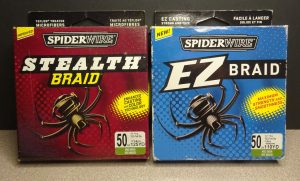Currently Empty: $0.00

As an avid angler, I’ve had the opportunity to try out a wide range of braided fishing lines over the years. Recently, I decided to put SpiderWire to the test. With its reputation in the fishing community, I approached this product with an open mind. However, my experience with SpiderWire was a mixed bag, marked by both commendable strengths and noticeable shortcomings.
First Impressions
Right from the start, SpiderWire’s packaging caught my attention. The sleek, modern design hinted at high performance, promising an advanced fishing experience. I opted for the SpiderWire Stealth Braid, a line known for its robustness and smooth finish. The line appeared thin yet strong out of the box, suggesting it would perform well in various fishing scenarios.
The line’s initial feel was promising. It was smooth to the touch, which typically is a good thing. The packaging also highlighted the line’s supposed strength and sensitivity, crucial factors for any serious angler. With these first impressions in mind, I was eager to put SpiderWire to the test on the water.
Performance on the Water
Casting Performance
Once on the water, SpiderWire exhibited several noteworthy strengths. One of the most impressive aspects was its casting performance. The line cast smoothly and effortlessly, allowing me to reach distant spots without much effort. This reduced friction during casting was a significant advantage, especially when placing my bait precisely where I wanted it. SpiderWire’s smooth casting ability can make a substantial difference in various fishing conditions, from open waters to more confined spaces.
Sensitivity
Another strong point was the line’s sensitivity. SpiderWire allowed me to feel even the faintest nibbles, which is crucial when targeting more finicky fish. This sensitivity gave me confidence in detecting bites early and setting the hook immediately. SpiderWire performed admirably in detecting subtle movements and vibrations.
Issues Encountered
Knot Strength
However, the line had its issues. One of the main problems I encountered was with knot strength. Despite following all the recommended techniques for tying knots with braided fishing lines, I experienced a few things that could have been improved. This was particularly frustrating during critical moments when I had a big catch on the line. Losing fish because of knot slippage is a major downside, which may happen frequently with some brands. This issue significantly impacted my confidence in the braided line, especially during high-stakes fishing trips.
Durability and Abrasion Resistance
Abrasion Resistance
In terms of durability, SpiderWire held up decently against abrasion. When fishing around rocky areas or submerged structures, the line showed resilience and didn’t fray as easily as other lines I’ve used. This robustness is vital, as fishing in challenging environments often leads to wear and tear. SpiderWire managed to withstand these conditions better than expected.
Wear and Tear
That being said, it wasn’t completely immune to wear and tear. Over time, I noticed the need to cut off damaged sections more often than I’d prefer. This added maintenance can be a hassle, especially during extended fishing trips. While SpiderWire demonstrated decent durability, it didn’t eliminate the need for regular checks and adjustments.
Comparison with Other Brands
Compared to other brands I’ve used, SpiderWire falls somewhere in the middle. It outperforms some budget options regarding casting and sensitivity but doesn’t match the top-tier lines regarding reliability and overall performance. The knot strength issue is a significant drawback, especially when targeting larger fish that put more strain on the line.
Premium Brands Comparison
For instance, compared to premium lines like PowerPro or Sufix 832, SpiderWire lacks the same level of reliability. These brands offer more consistent performance, particularly regarding knot strength and durability. While SpiderWire provides a smooth casting experience and good sensitivity, it reaches a height difference from its top competitors.
Conclusion
In conclusion, SpiderWire is a solid choice for casual anglers who appreciate good casting distance and sensitivity. Its smooth casting and ability to detect subtle bites make it a reliable option for various fishing scenarios. However, for serious fishing trips where every catch counts, the reliability issues, particularly with knot strength, make it a less appealing option.
Overall Evaluation
While SpiderWire has its strengths, it doesn’t quite live up to the hype for me, especially compared to some of its competitors. The knot failures and the need for frequent maintenance detract from the overall experience. There are other lines out there that offer better overall performance without the frustration of unexpected failures.


